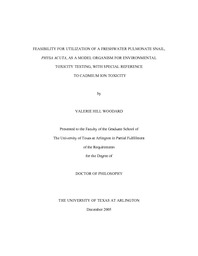
ATTENTION: The works hosted here are being migrated to a new repository that will consolidate resources, improve discoverability, and better show UTA's research impact on the global community. We will update authors as the migration progresses. Please see MavMatrix for more information.
Show simple item record
| dc.contributor.author | Woodard, Valerie | en_US |
| dc.date.accessioned | 2007-08-23T01:56:26Z | |
| dc.date.available | 2007-08-23T01:56:26Z | |
| dc.date.issued | 2007-08-23T01:56:26Z | |
| dc.date.submitted | August 2005 | en_US |
| dc.identifier.other | DISS-1079 | en_US |
| dc.identifier.uri | http://hdl.handle.net/10106/296 | |
| dc.description.abstract | The benefits of developing the pond snail, Physa acuta, as a model species for testing acute and chronic toxicity of aquatic pollutants include its wide North American distribution, ease of field collection and laboratory maintenance, and efficacy in testing toxicity responses including mortality, crawling behavior, reproduction and metabolism under both field and laboratory conditions.
Mortality, as 50 % sample lethal concentration (LC50) and 50 % sample lethal time (LT50) values with increased cadmium chloride (CdCl2) concentration in both acute 192 h and chronic 672 h tests. A new endpoint of 50 % sample crawl-out response (CO50) proved to be a highly efficacious measure of CdCl2 toxicity. It was an order of magnitude more sensitive than mortality testing with endpoint response being rapidly determined at 1-12 h exposure periods.
Both maximum likelihood probit and logistic regression analysis revealed a significant effect of CdCl2 concentration on egg mass oviposition and egg hatching. Similar effects were revealed by general linearized regression analyses on the number of egg masses and eggs oviposited and number of days to egg hatching; by logistic regression on number of embryos developing from eggs; and mixed model least squares regression on the new endpoint of egg diameter. All reproductive responses were significantly different from the control at 5 µg CdCl2·L-1.
Oxygen consumption rate (MO2) differed from controls in snails exposed to 1200 µg CdCl2·L-1, while there was no significant effect on oxygen regulation during progressive hypoxia.
Shell length was significantly correlated with mortality, crawl-out response, number of egg masses and eggs oviposited, egg hatching, egg diameter and acute oxygen consumption.
The results strongly indicated that Physa acuta could be an excellent new model organism for aquatic toxicity testing. | en_US |
| dc.description.sponsorship | McMahon, Robert | en_US |
| dc.language.iso | EN | en_US |
| dc.publisher | Biology | en_US |
| dc.title | Feasibility For Utilization Of A Freshwater Pulmonate Snail, Physa acuta, As A Model Organism For Environmental Toxicity Testing, With Special Reference To Cadmium Ion Toxicity | en_US |
| dc.type | Ph.D. | en_US |
| dc.contributor.committeeChair | McMahon, Robert | en_US |
| dc.degree.department | Biology | en_US |
| dc.degree.discipline | Biology | en_US |
| dc.degree.grantor | University of Texas at Arlington | en_US |
| dc.degree.level | doctoral | en_US |
| dc.degree.name | Ph.D. | en_US |
| dc.identifier.externalLink | https://www.uta.edu/ra/real/editprofile.php?onlyview=1&pid=89 | |
| dc.identifier.externalLinkDescription | Link to Research Profiles | |
Files in this item
- Name:
- umi-uta-1079.pdf
- Size:
- 2.243Mb
- Format:
- PDF
This item appears in the following Collection(s)
Show simple item record


